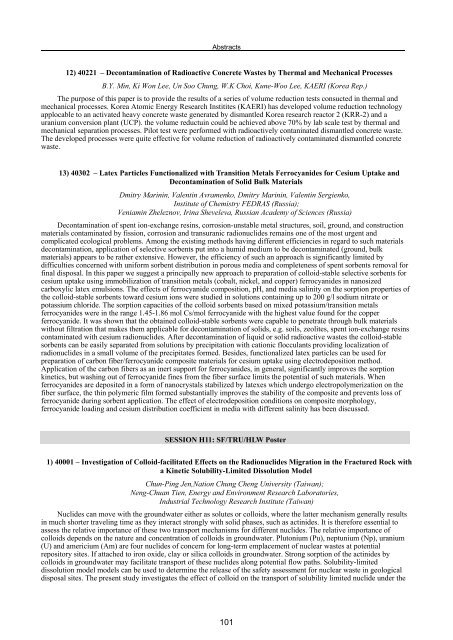The 13th International Conference on Environmental ... - Events
The 13th International Conference on Environmental ... - Events
The 13th International Conference on Environmental ... - Events
You also want an ePaper? Increase the reach of your titles
YUMPU automatically turns print PDFs into web optimized ePapers that Google loves.
Abstracts<br />
12) 40221 – Dec<strong>on</strong>taminati<strong>on</strong> of Radioactive C<strong>on</strong>crete Wastes by <str<strong>on</strong>g>The</str<strong>on</strong>g>rmal and Mechanical Processes<br />
B.Y. Min, Ki W<strong>on</strong> Lee, Un Soo Chung, W.K Choi, Kune-Woo Lee, KAERI (Korea Rep.)<br />
<str<strong>on</strong>g>The</str<strong>on</strong>g> purpose of this paper is to provide the results of a series of volume reducti<strong>on</strong> tests c<strong>on</strong>sucted in thermal and<br />
mechanical processes. Korea Atomic Energy Research Institites (KAERI) has developed volume reducti<strong>on</strong> technology<br />
applocable to an activated heavy c<strong>on</strong>crete waste generated by dismantled Korea research reactor 2 (KRR-2) and a<br />
uranium c<strong>on</strong>versi<strong>on</strong> plant (UCP). the volume reductuin could be achieved above 70% by lab scale test by thermal and<br />
mechanical separati<strong>on</strong> processes. Pilot test were performed with radioactively c<strong>on</strong>taninated dismantled c<strong>on</strong>crete waste.<br />
<str<strong>on</strong>g>The</str<strong>on</strong>g> developed processes were quite effective for volume reducti<strong>on</strong> of radioactively c<strong>on</strong>taminated dismantled c<strong>on</strong>crete<br />
waste.<br />
13) 40302 – Latex Particles Functi<strong>on</strong>alized with Transiti<strong>on</strong> Metals Ferrocyanides for Cesium Uptake and<br />
Dec<strong>on</strong>taminati<strong>on</strong> of Solid Bulk Materials<br />
Dmitry Marinin, Valentin Avramenko, Dmitry Marinin, Valentin Sergienko,<br />
Institute of Chemistry FEDRAS (Russia);<br />
Veniamin Zheleznov, Irina Sheveleva, Russian Academy of Sciences (Russia)<br />
Dec<strong>on</strong>taminati<strong>on</strong> of spent i<strong>on</strong>-exchange resins, corrosi<strong>on</strong>-unstable metal structures, soil, ground, and c<strong>on</strong>structi<strong>on</strong><br />
materials c<strong>on</strong>taminated by fissi<strong>on</strong>, corrosi<strong>on</strong> and transuranic radi<strong>on</strong>uclides remains <strong>on</strong>e of the most urgent and<br />
complicated ecological problems. Am<strong>on</strong>g the existing methods having different efficiencies in regard to such materials<br />
dec<strong>on</strong>taminati<strong>on</strong>, applicati<strong>on</strong> of selective sorbents put into a humid medium to be dec<strong>on</strong>taminated (ground, bulk<br />
materials) appears to be rather extensive. However, the efficiency of such an approach is significantly limited by<br />
difficulties c<strong>on</strong>cerned with uniform sorbent distributi<strong>on</strong> in porous media and completeness of spent sorbents removal for<br />
final disposal. In this paper we suggest a principally new approach to preparati<strong>on</strong> of colloid-stable selective sorbents for<br />
cesium uptake using immobilizati<strong>on</strong> of transiti<strong>on</strong> metals (cobalt, nickel, and copper) ferrocyanides in nanosized<br />
carboxylic latex emulsi<strong>on</strong>s. <str<strong>on</strong>g>The</str<strong>on</strong>g> effects of ferrocyanide compositi<strong>on</strong>, pH, and media salinity <strong>on</strong> the sorpti<strong>on</strong> properties of<br />
the colloid-stable sorbents toward cesium i<strong>on</strong>s were studied in soluti<strong>on</strong>s c<strong>on</strong>taining up to 200 g/l sodium nitrate or<br />
potassium chloride. <str<strong>on</strong>g>The</str<strong>on</strong>g> sorpti<strong>on</strong> capacities of the colloid sorbents based <strong>on</strong> mixed potassium/transiti<strong>on</strong> metals<br />
ferrocyanides were in the range 1.45-1.86 mol Cs/mol ferrocyanide with the highest value found for the copper<br />
ferrocyanide. It was shown that the obtained colloid-stable sorbents were capable to penetrate through bulk materials<br />
without filtrati<strong>on</strong> that makes them applicable for dec<strong>on</strong>taminati<strong>on</strong> of solids, e.g. soils, zeolites, spent i<strong>on</strong>-exchange resins<br />
c<strong>on</strong>taminated with cesium radi<strong>on</strong>uclides. After dec<strong>on</strong>taminati<strong>on</strong> of liquid or solid radioactive wastes the colloid-stable<br />
sorbents can be easily separated from soluti<strong>on</strong>s by precipitati<strong>on</strong> with cati<strong>on</strong>ic flocculants providing localizati<strong>on</strong> of<br />
radi<strong>on</strong>uclides in a small volume of the precipitates formed. Besides, functi<strong>on</strong>alized latex particles can be used for<br />
preparati<strong>on</strong> of carb<strong>on</strong> fiber/ferrocyanide composite materials for cesium uptake using electrodepositi<strong>on</strong> method.<br />
Applicati<strong>on</strong> of the carb<strong>on</strong> fibers as an inert support for ferrocyanides, in general, significantly improves the sorpti<strong>on</strong><br />
kinetics, but washing out of ferrocyanide fines from the fiber surface limits the potential of such materials. When<br />
ferrocyanides are deposited in a form of nanocrystals stabilized by latexes which undergo electropolymerizati<strong>on</strong> <strong>on</strong> the<br />
fiber surface, the thin polymeric film formed substantially improves the stability of the composite and prevents loss of<br />
ferrocyanide during sorbent applicati<strong>on</strong>. <str<strong>on</strong>g>The</str<strong>on</strong>g> effect of electrodepositi<strong>on</strong> c<strong>on</strong>diti<strong>on</strong>s <strong>on</strong> composite morphology,<br />
ferrocyanide loading and cesium distributi<strong>on</strong> coefficient in media with different salinity has been discussed.<br />
SESSION H11: SF/TRU/HLW Poster<br />
1) 40001 – Investigati<strong>on</strong> of Colloid-facilitated Effects <strong>on</strong> the Radi<strong>on</strong>uclides Migrati<strong>on</strong> in the Fractured Rock with<br />
a Kinetic Solubility-Limited Dissoluti<strong>on</strong> Model<br />
Chun-Ping Jen,Nati<strong>on</strong> Chung Cheng University (Taiwan);<br />
Neng-Chuan Tien, Energy and Envir<strong>on</strong>ment Research Laboratories,<br />
Industrial Technology Research Institute (Taiwan)<br />
Nuclides can move with the groundwater either as solutes or colloids, where the latter mechanism generally results<br />
in much shorter traveling time as they interact str<strong>on</strong>gly with solid phases, such as actinides. It is therefore essential to<br />
assess the relative importance of these two transport mechanisms for different nuclides. <str<strong>on</strong>g>The</str<strong>on</strong>g> relative importance of<br />
colloids depends <strong>on</strong> the nature and c<strong>on</strong>centrati<strong>on</strong> of colloids in groundwater. Plut<strong>on</strong>ium (Pu), neptunium (Np), uranium<br />
(U) and americium (Am) are four nuclides of c<strong>on</strong>cern for l<strong>on</strong>g-term emplacement of nuclear wastes at potential<br />
repository sites. If attached to ir<strong>on</strong> oxide, clay or silica colloids in groundwater. Str<strong>on</strong>g sorpti<strong>on</strong> of the actinides by<br />
colloids in groundwater may facilitate transport of these nuclides al<strong>on</strong>g potential flow paths. Solubility-limited<br />
dissoluti<strong>on</strong> model models can be used to determine the release of the safety assessment for nuclear waste in geological<br />
disposal sites. <str<strong>on</strong>g>The</str<strong>on</strong>g> present study investigates the effect of colloid <strong>on</strong> the transport of solubility limited nuclide under the<br />
101
















